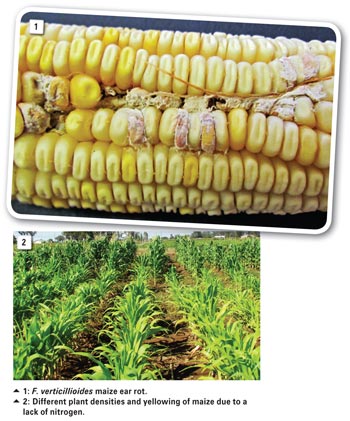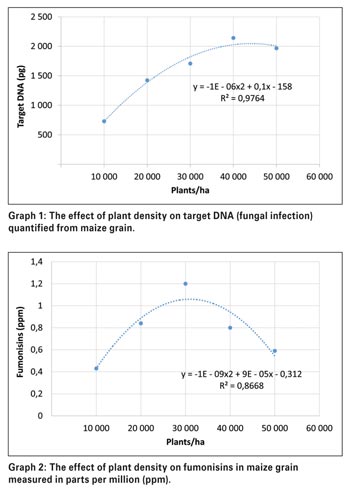September 2016
BELINDA JANSE VAN RENSBURG, ARC-Grain Crops Institute, Potchefstroom
 Fusarium verticillioides (Photo 1) is an important ear rot pathogen of maize. F. verticillioides can also cause root and stalk rot of maize and can lead to great economic losses due to yield and grain quality reduction.
Fusarium verticillioides (Photo 1) is an important ear rot pathogen of maize. F. verticillioides can also cause root and stalk rot of maize and can lead to great economic losses due to yield and grain quality reduction.
Symptoms vary depending upon genotype, environment and disease severity. F. verticillioides can produce fumonisins which are secondary metabolites that can cause various diseases in animals. It is also statistically linked with oesophageal cancer in humans.
In the warmer maize production regions increased fumonisin levels are not uncommon in grain, compared to the temperate production regions. It has been shown that abiotic factors such as substrate, temperature and water activity can significantly influence fumonisin synthesis and therefore the ARC-Grain Crops Institute’s (ARC-GCI) research focus is on the effect that abiotic plant stressors have on F. verticillioides infection and fumonisin synthesis in maize grain.
Plant density field trials with a decline in nitrogen
Four plant density field trials were planted in Potchefstroom (2011 - 2014) using cultivars PAN 6P-110 and CRN 3505. Soil analysis was conducted at each experimental plot before planting. No fertilisers were applied to ensure gradual depletion of nitrogen in the soil.
Plant densities comprised of 10 000, 20 000, 30 000, 40 000 and 50 000 plants/ha (Photo 2). These plant densities (treatments) and cultivars were planted in a complete randomised block design. The size of each plot was 12 m x 8 m.
To obtain the plant densities of 10 000, 20 000, 30 000, 40 000 and 50 000 plants/ha, kernels were planted at 0,9 m (inter-row) x 15 cm (intra-row), 0,9 m x 30 cm, 1 m x 30 cm, 1,2 m x 30 cm and 2 m x 30 cm, respectively. Maize ears were hand harvested and threshed. Kernels of individual maize samples were milled and subjected to different laboratory analysis (quantitative PCR and high performance liquid chromatography) in order to quantify how much of the F. verticillioides fungi and fumonisins were present in the grain.
Results show that the interaction between plant density and cultivar had a highly significant effect on F. verticillioides infection of maize grain. CRN 3505 had higher mean F. verticillioides infection compared to PAN 6P-110 at 10 000 and 20 000 plant/ha (combined data of the four seasons).
Results show that the interaction between plant density and season had a highly significant effect on fumonisins in grain. Fumonisins were significantly higher at the onset of the trials (2011/2012) at 10 000, 20 000, 30 000 and 40 000 plants/ha. Thereafter fumonisins were most prominent in the 10 000 plants/ha treatment for seasons 2011/2012, 2012/2013 and 2013/2014.
As the years progressed the soil nitrogen levels declined from 2,93 mg/kg - 1,09 mg/kg. This study showed that under these conditions, cultivar and low plant densities can lead to elevated fungal infection in maize grain. Environment (seasons) and lower plant densities can lead to elevated fumonisins in maize grain.
 These findings show that smallholder and developing farmers can be at risk to fungal infection and fumonisin contamination of maize grain. Maize planting methods by these farmers (seed broadcasting and planting in the plough furrow) often result in poor and scattered maize stands (Du Toit & Nemadodzi, 2008).
These findings show that smallholder and developing farmers can be at risk to fungal infection and fumonisin contamination of maize grain. Maize planting methods by these farmers (seed broadcasting and planting in the plough furrow) often result in poor and scattered maize stands (Du Toit & Nemadodzi, 2008).
Smallholder and developing farmers often make use of mechanical planters operated by contractors. These contractors are not always aware of the correct implementation of planting practices (Du Toit & Nemadodzi, 2008), thereby putting the farmer’s yield at risk due to incorrect planting depths and row spacing.
Plant density field trial with adequate nitrogen
This trial was planted in Potchefstroom (2015) at the five plant densities described above, replicated three times, using cultivars CRN 3505, PAN 6P-110, SC 608, LS 8537, PAN 6Q245, LS 8518, IPM 52-11R, P 2432R in a split plot design. Ears were naturally infected and hand harvested. Kernels of individual maize samples were milled and subjected to different laboratory analysis as described above.
Results show plant density to have a significant effect on F. verticillioides infection as well as fumonisin production in maize grain. A strong relationship between plant density and fungal infection (target DNA) can be observed (Graph 1). Fungal infection increased as plant densities increased. Similarly, fumonisins increased as plant density increased up to 30 000 plants/ha and then fumonisins decreased at 40 000 and 50 000 plants/ha (Graph 2).
According to the maize production guideline of the ARC-GCI, a plant population of 24 000 plants/ha will yield 5 t/ha (for each of the selected eight cultivars). We can therefore use 24 000 plants/ha as a control.
In the study, the influence of plant density on F. verticillioides fungal infection and fumonisins quantified from grain in the 2015/2016 season at Potchefstroom showed an increase in target DNA and fumonisins (up to 30 000 plants/ha) as plant densities increased. This is in line with published research that reported an increase in disease severity and fumonisins at higher plant densities.
 According to Munkvold (2003) higher plant populations lead to a lower air flow in the row-space with higher relative humidity and promote fungal infection and colonisation of the maize ears. This study shows that producers should carefully consider the genotype and plant population in their own respective environments before planting to ensure that yields are in accordance with accepted food safety limits, including fungal contamination and mycotoxin production.
According to Munkvold (2003) higher plant populations lead to a lower air flow in the row-space with higher relative humidity and promote fungal infection and colonisation of the maize ears. This study shows that producers should carefully consider the genotype and plant population in their own respective environments before planting to ensure that yields are in accordance with accepted food safety limits, including fungal contamination and mycotoxin production.
References
Du Toit, APN & Nemadodzi, EA. 2008. Evaluation of the appropriateness of certain grain production technologies for small-scale farmers. South African Journal of Agricultural Extension, 37:132 - 142.
Munkvold, GP. 2003. Epidemiology of Fusarium diseases and their mycotoxins in maize ears. European Journal of Plant Pathology, 109:705 - 713.
Publication: September 2016
Section: On farm level